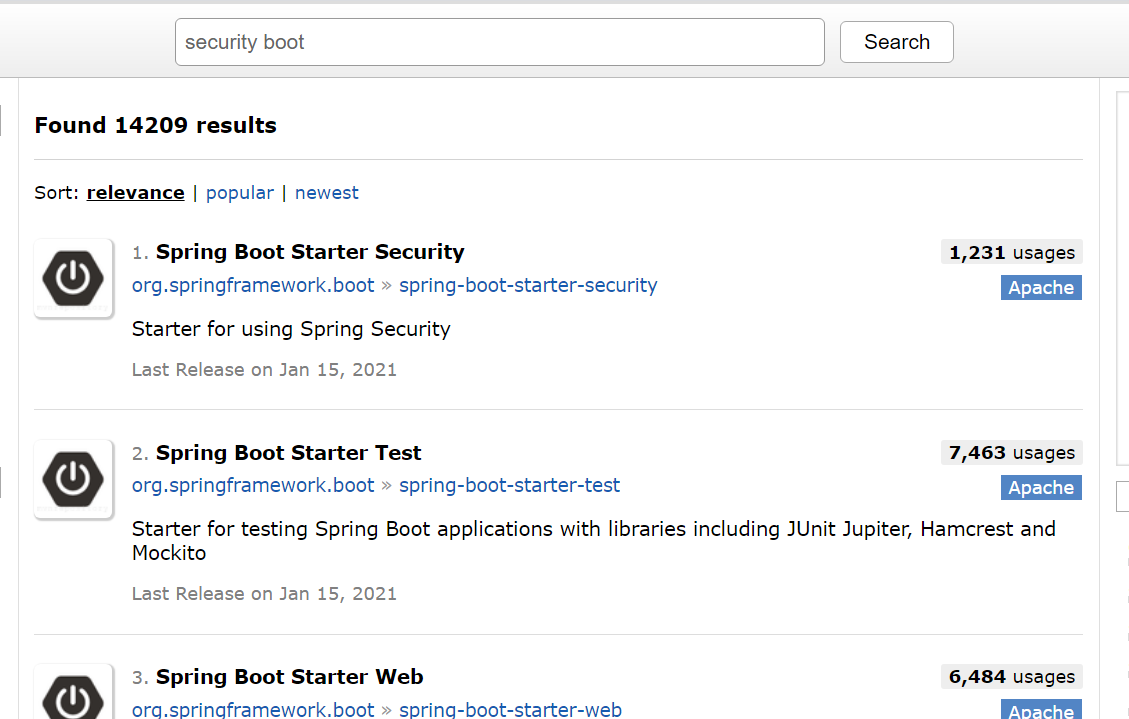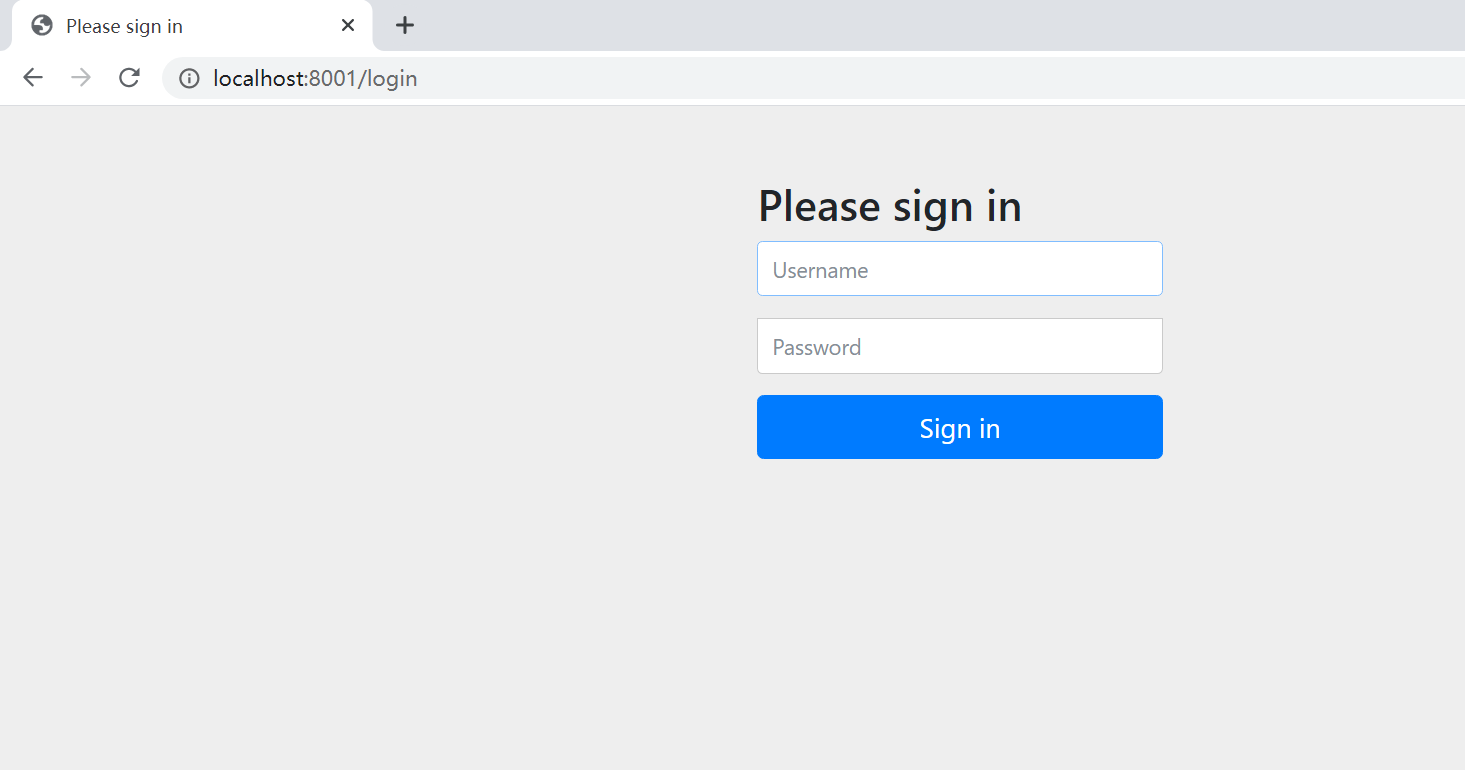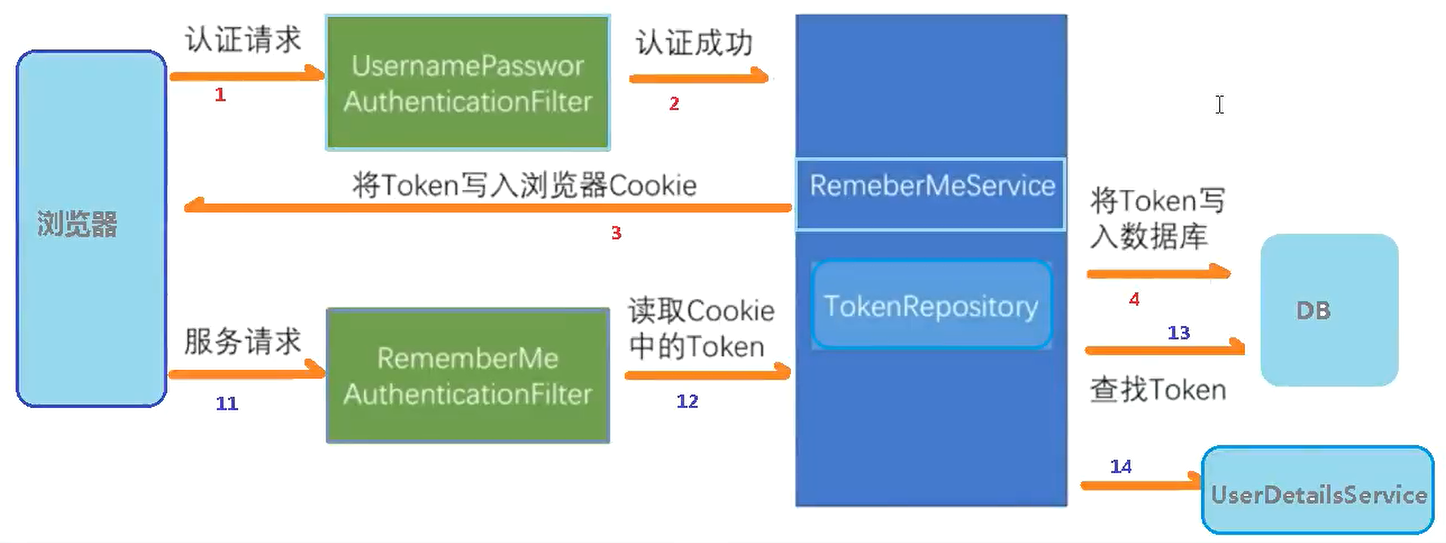SpringBoot + Security学习笔记
SpringSecurity学习笔记
本以为是总结,最后写成了笔记,所以还是需要更加的努力啊。
开始的时候看了一遍官方文档,然后只看懂了加密器。
然后又学了一个尚硅谷的视频,虽然这个教程是在讲一个项目,但我没有听懂(应该是我自己的问题)
代码 https://gitee.com/pilearn/learning-spring-security
中文版文档 https://www.springcloud.cc/spring-security.html
尚硅谷视频链接 https://www.bilibili.com/video/BV15a411A7kP
什么是SpringSecurity
Security是Spring全家桶中一个安全框架,他的扩展能力非常的强,底层是一条过滤器链。通过简单的配置就可以使用,但通过自己的DIY,可以把每个权限细化到每个链接上去。
shiro没有学,但只推荐学一个安全框架
这里搭建的学习项目都是使用SpringBoot
获取SpringSecurity
你可以在maven官网获取最新版本

<dependency><groupId>org.springframework.boot</groupId><artifactId>spring-boot-starter-security</artifactId><version>2.4.2</version></dependency>
开始一个SpringBoot项目
<?xml version="1.0" encoding="UTF-8"?><project xmlns="http://maven.apache.org/POM/4.0.0" xmlns:xsi="http://www.w3.org/2001/XMLSchema-instance"xsi:schemaLocation="http://maven.apache.org/POM/4.0.0 https://maven.apache.org/xsd/maven-4.0.0.xsd"><modelVersion>4.0.0</modelVersion><parent><groupId>org.springframework.boot</groupId><artifactId>spring-boot-starter-parent</artifactId><version>2.4.2</version><relativePath/> <!-- lookup parent from repository --></parent><groupId>com.pipihao</groupId><artifactId>securitylearn</artifactId><version>0.0.1-SNAPSHOT</version><name>securitylearn</name><description>Demo project for Spring Boot</description><properties><java.version>1.8</java.version></properties><dependencies><dependency><groupId>com.alibaba</groupId><artifactId>druid</artifactId><version>1.1.21</version></dependency><dependency><groupId>org.springframework.boot</groupId><artifactId>spring-boot-starter-thymeleaf</artifactId></dependency><dependency><groupId>org.springframework.boot</groupId><artifactId>spring-boot-starter-security</artifactId></dependency><dependency><groupId>org.springframework.boot</groupId><artifactId>spring-boot-starter-web</artifactId></dependency><dependency><groupId>org.mybatis.spring.boot</groupId><artifactId>mybatis-spring-boot-starter</artifactId><version>2.1.4</version></dependency><dependency><groupId>mysql</groupId><artifactId>mysql-connector-java</artifactId><scope>runtime</scope></dependency><dependency><groupId>org.projectlombok</groupId><artifactId>lombok</artifactId><optional>true</optional></dependency><dependency><groupId>org.springframework.boot</groupId><artifactId>spring-boot-starter-test</artifactId><scope>test</scope></dependency><dependency><groupId>org.springframework.security</groupId><artifactId>spring-security-test</artifactId><scope>test</scope></dependency></dependencies><build><plugins><plugin><groupId>org.springframework.boot</groupId><artifactId>spring-boot-maven-plugin</artifactId><configuration><excludes><exclude><groupId>org.projectlombok</groupId><artifactId>lombok</artifactId></exclude></excludes></configuration></plugin></plugins></build></project>
项目配置文件
server:port: 8001spring:datasource:url: jdbc:mysql://localhost:3306/demo?serverTimezone=Asia/Shanghaiusername: rootpassword: rootdriver-class-name: com.mysql.cj.jdbc.Driverthymeleaf:cache: false# 因为Thymeleaf很多有默认配置,所以只关了这个缓存,方便刷新
数据库文件
数据库版本为 8.0
运行项目


登录
用户名:user
密码:控制台输出的这密码
配置Security
方法一:通过配置文件修改登录账号密码
spring:security:user:name: xxpassword: xx
方法二:通过自定义配置SecurityConfig配置类
WebSecurityConfigurerAdapter 类是是Security内置提供了一个默认身份验证的抽象类,继承此抽象类实现configure方法则可以对验证操作实现DIY。[于官方文档 6.3 标题可见]
UserDetailsService接口:查询数据库用户名和密码过程
- 创建类继承UsernamePasswordAuthenticationFilter,重写三个方法
* - 创建类实现UserDetailService,编写查询数据过程,返回User对象,这个User对象是安全框架提供对象。
- PasswordEncoder: 数据加密接口,用于返回User对象里面的密码加密
方法三:自定义配置类UserDetailsService
定义不验证链接
@Overrideprotected void configure(HttpSecurity http) throws Exception {/*使用and()方法表示关闭XML标记的Java配置,它允许我们继续配置父标记。如果您阅读代码,它也是有道理的。我想配置授权请求并配置表单登录并配置HTTP基本身份验证。*/http.authorizeRequests().antMatchers("/","/no").permitAll() //可以直接访问的路径.anyRequest().authenticated().and().formLogin().loginPage("/login.html") //配置登录路径.loginProcessingUrl("/doLogin").defaultSuccessUrl("/hallo").permitAll(); //设置 登录的网页http.csrf().disable(); //如果注释了这一行,全部要用_csrf的对象来验证了}
配置访问权限/角色
如果是配置访问角色则使用是hasRole与hasAnyRole
这里非常建议点一下看一下hasRole的源码 使用Role的时候,User的权限列表是需要加ROLE_前缀的
这里直接使用的是hasAnyAuthority,还有一个方法是hasAuthority
前者可以配置多个权限,而后者只能配置一个权限
接口只是显示一个字符串
@GetMapping("test")public String sayTest(){return "Test";}
SecurityConfig代码
@Overrideprotected void configure(HttpSecurity http) throws Exception {/*使用and()方法表示关闭XML标记的Java配置,它允许我们继续配置父标记。如果您阅读代码,它也是有道理的。我想配置授权请求并配置表单登录并配置HTTP基本身份验证。*/http.authorizeRequests().antMatchers("/","/no").permitAll() //可以直接访问的路径.antMatchers("/test").hasAnyAuthority("admin") // 访问权限.anyRequest().authenticated().and().formLogin().loginPage("/login.html") //配置登录路径.loginProcessingUrl("/doLogin").defaultSuccessUrl("/hallo").permitAll(); //设置 登录的网页http.csrf().disable(); //如果注释了这一行,全部要用_csrf的对象来验证了}
UserDetailsImpl代码
@Overridepublic UserDetails loadUserByUsername(String username) throws UsernameNotFoundException {if(StringUtils.isEmpty(username)){throw new RuntimeException("用户名不能为空");}IUser iUser= userMapper.getUserByUsername(username);if(iUser == null){throw new UsernameNotFoundException("无此用户");}/*此处查询用户角色*/List<GrantedAuthority> grantedAuthorityList =AuthorityUtils.createAuthorityList("admin"); // 权限的列表return new User(iUser.getUsername(),bCryptPasswordEncoder.encode(iUser.getPassword()),grantedAuthorityList);}
自定义403界面
// 在此方法内加上一行 protected void configure(HttpSecurity http)http.exceptionHandling().accessDeniedPage("/unauth.html");
权限注解
@Secured
判断是否有角色,这里匹配的角色需要加前缀ROLE_
@GetMapping("update")@Secured({"ROLE_manager"})public String update(){return "update";}
使用其功能时需要在application类上开起
@SpringBootApplication@MapperScan("com.pipihao.securitylearn.mapper")@EnableGlobalMethodSecurity(securedEnabled = true)public class SecuritylearnApplication {public static void main(String[] args) {SpringApplication.run(SecuritylearnApplication.class, args);}}
UserDetailsServiceImpl
List<GrantedAuthority> grantedAuthorityList =AuthorityUtils.createAuthorityList("admin","ROLE_manager");
@PreAuthorize & @PostAuthorize
此注解即有权限验证功能,又有角色验证功能
@GetMapping("pre1")@PreAuthorize("hasAnyRole('ROLE_manager')")public String prePost1(){return "prePost1";}@GetMapping("pre2")@PreAuthorize("hasAnyAuthority('admin')")public String prePost2(){return "prePost2";}
@SpringBootApplication@EnableGlobalMethodSecurity(prePostEnabled = true)public class SecuritylearnApplication {public static void main(String[] args) {SpringApplication.run(SecuritylearnApplication.class, args);}}
@PostAuthorize 与@PreAuthorize的区别就是,Pre会先拦截后执行,而PostAuthorize是先执行,后拦截
所以我例子中没有过多的讲
@PreFilter & @PostFilter
Pre是过滤上传的数据,Post过滤返回的数据
@GetMapping("list")@PostFilter("filterObject.username != 'admin' ")public List<IUser> list(){List<IUser> iUsers = new ArrayList<>();iUsers.add(new IUser(1,"admin","123"));iUsers.add(new IUser(2,"user","123"));return iUsers;}// Applicationo类上还是要加上下面这个注解,并设置属性值@EnableGlobalMethodSecurity(prePostEnabled = true)
效果图

上传则是同理,通过注解写好判断,然后测试即可,注:PreFilter过滤的也只是集合和数组
用户注销
/*配置退出登录*/http.logout().logoutUrl("/logout").logoutSuccessUrl("no").permitAll();
登录后,直接通过浏览器,访问此路径即可(是的,就是如此)
location.href='/logout';
自动登录
下面是尚硅谷老师写的原理图和执行流程

如果是微服务,则把数据库改成redis,把cookie改成jwt生成的token

Security 中的一个类内JdbcTokenRepositoryImpl
的常量CREATE_TABLE_SQL
create table persistent_logins (username varchar(64) not null, series varchar(64) primary key, token varchar(64) not null, last_used timestamp not null)
有兴趣的可以看看源码 没兴趣的直接在你使用的数据库内执行上面这行sql创建一个保存登录信息的表

JdbcTokenRepositoryImpl 是PersistentTokenRepository实现类
下面这种写那么应该是多态了
@Autowiredprivate DataSource dataSource;@Beanpublic PersistentTokenRepository persistentTokenRepository(){JdbcTokenRepositoryImpl jdbcTokenRepository = new JdbcTokenRepositoryImpl();jdbcTokenRepository.setDataSource(dataSource);//jdbcTokenRepository.setCreateTableOnStartup(true); 设置启动时创建自动登录表return jdbcTokenRepository;}
SecurityConfig的方法
@Overrideprotected void configure(HttpSecurity http) throws Exception {/*自定义403链接*/http.exceptionHandling().accessDeniedPage("/unauth.html");/*配置退出登录*/http.logout().logoutUrl("/logout").logoutSuccessUrl("/no").permitAll();/*使用and()方法表示关闭XML标记的Java配置,它允许我们继续配置父标记。如果您阅读代码,它也是有道理的。我想配置授权请求并配置表单登录并配置HTTP基本身份验证。*/http.authorizeRequests().antMatchers("/","/no").permitAll() //可以直接访问的路径.antMatchers("/test").hasAnyAuthority("admin").antMatchers("/unauth").hasAnyAuthority("xxx").anyRequest().authenticated().and().formLogin().loginPage("/login.html") //配置登录路径.loginProcessingUrl("/doLogin").defaultSuccessUrl("/hallo").permitAll()// -------------------就是下面这坨.and().rememberMe().tokenRepository(persistentTokenRepository()).tokenValiditySeconds(60) // 自动保存的时间,秒为单位.userDetailsService(userDetailsService); //设置 登录的网页http.csrf().disable(); //如果注释了这一行,全部要用_csrf的对象来验证了}
下面是登录界面
<form action="/doLogin" method="POST">user:<input type="text" name="username"><br>pswd:<input type="text" name="password"><br><!--必须name=remember-me不然,是无法接收到是否自动登录的信息的-->自动登录 <input type="checkbox" name="remember-me"><br><input type="submit"></form>
然后在登录的时候打个勾,就可以自动登录了
在DB中会出现如下的信息

CSRF指令认证
第一步 把下面这一行注释了就开启了,也就是说他其实是默认开启的
如果没有关闭,则会NullPointerException
//http.csrf().disable();
Spring Security CSRF 会针对Patch,Post,Put,Delete方法进行防护。(都是一些要更改数据的方法)
系统默认提供了一个csrfToken对象放在HttpSession中,也就是我们所见到了_csrf对象
此对象可以直接使用
开启CSRF后,则登录的时【POST】,也需要验证CSRF,而使用HttpSession则需要使用模板引擎,这里我们使用的是Thymeleaf而非JSP。(大同小异)
注:使用Thymeleaf的时候,类上的Controller注解不能写成RestController,不然无法生效的
@Controllerpublic class LoginController {@GetMapping("login")public String login(){return "login";}}
<!doctype html><html xmlns:th="http://www.thymeleaf.org"><head><meta charset="UTF-8"><meta name="viewport"content="width=device-width, user-scalable=no, initial-scale=1.0, maximum-scale=1.0, minimum-scale=1.0"><meta http-equiv="X-UA-Compatible" content="ie=edge"><title>登录</title></head><body><!--没加th:则不会有隐藏域自动生成--><form th:action="'/doLogin'" method="POST">user:<input type="text" name="username"><br>pswd:<input type="text" name="password"><br><!--必须name=remember-me不然,是无法接收到是否自动登录的信息的-->自动登录 <input type="checkbox" name="remember-me"><br><input type="submit"></form></body></html>
切记,默认开了CSRF,则每个表单中应当手动添加一个隐藏域
当Thymeleaf因为你使用了th,则自动给你生成了。
所以 th:action="'/doLogin'" 这样写可以省事
如下图

总结
本是总结,谁知还是变成了学习笔记。总结代表着会,笔记代表着只能用,说不出什么名堂。这是看第二遍,当然,这也会像我用正则一样,每次用正则的时候,都要学一遍正则。
或许SpringSecurity并不难,难的只是步骤有点多。
老师讲的很不错,多听几遍就会了。
关于提高技术,应该看文档,把他提供的API都自己看懂。像用Redist代替DB,这样的微服务中,使用,很有效率。
接下来,我还会继续学习Security,并出些新笔记,这最多算是一个听课笔记。
SpringBoot + Security学习笔记的更多相关文章
- SpringBoot + Spring Security 学习笔记(五)实现短信验证码+登录功能
在 Spring Security 中基于表单的认证模式,默认就是密码帐号登录认证,那么对于短信验证码+登录的方式,Spring Security 没有现成的接口可以使用,所以需要自己的封装一个类似的 ...
- SpringBoot + Spring Security 学习笔记(三)实现图片验证码认证
整体实现逻辑 前端在登录页面时,自动从后台获取最新的验证码图片 服务器接收获取生成验证码请求,生成验证码和对应的图片,图片响应回前端,验证码保存一份到服务器的 session 中 前端用户登录时携带当 ...
- SpringBoot + Spring Security 学习笔记(二)安全认证流程源码详解
用户认证流程 UsernamePasswordAuthenticationFilter 我们直接来看UsernamePasswordAuthenticationFilter类, public clas ...
- SpringBoot 完整学习笔记免费分享
从0到进阶,完全系统性的学习笔记 每次我都会反复拿来观看,因为我们总会有遗漏忘记的地方,但是笔记不会. 希望大家能好好利用它,以下是笔记截图! 以上只是其中的一项部分,这份笔记可以说含金量超高,绝对会 ...
- SpringBoot + Spring Security 学习笔记(四)记住我功能实现
记住我功能的基本原理 当用户登录发起认证请求时,会通过UsernamePasswordAuthenticationFilter进行用户认证,认证成功之后,SpringSecurity 调用前期配置好的 ...
- SpringBoot + Spring Security 学习笔记(一)自定义基本使用及个性化登录配置
官方文档参考,5.1.2 中文参考文档,4.1 中文参考文档,4.1 官方文档中文翻译与源码解读 SpringSecurity 核心功能: 认证(你是谁) 授权(你能干什么) 攻击防护(防止伪造身份) ...
- Windows Security 学习笔记
对于Windows 在 Security 方面的学习. 纯兴趣. UNIX 的另外开一条路线学习. 话说今天查gpedit.msc的资料的时候发现 M$ 官网上怎么连个文档都没有. 后来才点了 gpe ...
- Spring Security学习笔记
Spring Web Security是Java web开发领域的一个认证(Authentication)/授权(Authorisation)框架,基于Servlet技术,更确切的说是基于Servle ...
- Spring Security学习笔记(三)
之前提到过认证后怎么存放用户信息,令牌token是一种方式,session是另一种方式,这里介绍使用spring session data redis存储httpSession. 添加了以上依赖后,我 ...
随机推荐
- SpringMVC听课笔记(三:使用@RequestMapping映射请求)
1. Spring MVC使用 @RequestMapping 注解为控制器指定可以处理哪些URL请求 2. 标注点: --类定义处:提供初步的请求映射信息.相对于WEB应用的根目录 --方法处:提供 ...
- 怎样将Sublime Text 设置成中文版(完整教程)
1.打开Sublime Text,使用快捷键Shift+Ctrl+P,弹出查找栏,如图: 2.在搜索框中输入关键字 install ,出现下拉选项,点击选择其中的:Package Control: I ...
- SpringMVC数据校验并通过国际化显示错误信息
目录 SpringMVC数据校验并通过国际化显示错误信息 SpringMVC数据校验 在页面中显示错误信息 通过国际化显示错误信息 SpringMVC数据校验并通过国际化显示错误信息 SpringMV ...
- 微信小程序分享之生成海报--canvas
首先看文档 了解知识点~~(https://developers.weixin.qq.com/miniprogram/dev/component/) githup:https://github.com ...
- Codeforce 380A Sereja and Prefixes【二分】
题意:定义两种操作 1 a ---- 向序列中插如一个元素a 2 a b ---- 将序列的前a个元素[e1,e2,...,ea]重复b次插入到序列中 经过一列操作后,为处于某个位置p的元素是多少.数 ...
- hdu1625 Numbering Paths (floyd判环)
Time Limit: 2000/1000 MS (Java/Others) Memory Limit: 65536/32768 K (Java/Others) Total Submission ...
- python 实现AES加密和解密
参考 https://blog.csdn.net/zhchs2012/article/details/79032656 AES加密算法是一种对称加密算法, 他有一个密匙, 即用来加密, 也用来解密 i ...
- Hyper-V安装CentOS修改分辨率
grubby --update-kernel=ALL --args="video=hyperv_fb:1600x900" reboot https://blog.csdn.net/ ...
- WSL2 使用Docker运行.NET Core
Docker的安装在前面说过了,此处就不说了,我们检查一下版本: 步入正题. 首先,我们为项目创建Dockerfile(无扩展名) 确保Docker是启动状态: 构建镜像,注意名称必须是全部小写(此处 ...
- aop详解与实战
1. 什么是AOP aop:面向切面编程.采用横向机制. oop:面向对象编程.采用纵向机制. AOP,面向切面编程.就是通过某个切入点(比如方法开始.结束)向某个切面(被切的对象)切入环绕通知(需要 ...
